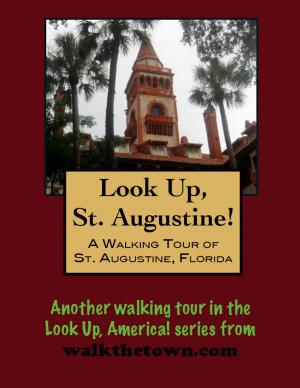Look Up, Detroit! A Walking Tour of Campus Martius Park
Nonfiction, Travel, United States, History, Americas| Author: | Doug Gelbert | ISBN: | 9781466025684 |
| Publisher: | Doug Gelbert | Publication: | October 12, 2011 |
| Imprint: | Smashwords Edition | Language: | English |
| Author: | Doug Gelbert |
| ISBN: | 9781466025684 |
| Publisher: | Doug Gelbert |
| Publication: | October 12, 2011 |
| Imprint: | Smashwords Edition |
| Language: | English |
There is no better way to see America than on foot. And there is no better way to appreciate what you are looking at than with a walking tour. Whether you are preparing for a road trip or just out to look at your own town in a new way, a downloadable walking tour is ready to explore when you are.
Each walking tour describes historical and architectural landmarks and provides pictures to help out when those pesky street addresses are missing. Every tour also includes a quick primer on identifying architectural styles seen on American streets.
Before Detroit became shorthand for the automobile industry it had grown into the 13th largest city in America with more than 285,000 people in 1900, first through fur trading and then on the manufacture of tobacco and varnish and shoes and pharmaceuticals and, most fortuitously, carriages and bicycles that would lay the foundation for production of cars in the 20th century.
In 1701, the French officer Antoine de la Mothe Cadillac, along with fifty-one additional French-Canadians, founded a settlement called Fort Ponchartrain du Détroit, naming it after the comte de Pontchartrain, Minister of Marine under Louis XIV. France offered free land to attract families to Detroit, which grew to 800 people in 1765, the largest city in the Americas between Montreal and New Orleans. After Great Britain ceded the Northwest Territory to the United States in 1796 under the Jay Treaty Detroit was named the capital of the Michigan Territory.
Through the 1800s Detroit grew into a thriving hub of commerce and industry. Then in the spring of 1896 Henry Ford built his own horseless carriage. In 1901 Ford challenged Alexander Winton and his world champion "Bullet" at Grosse Pointe race track outside Detroit. Three cars lined up for the ten-mile race but only Ford and Winton left the line. Winton led Ford for 8 miles but sputtered badly as the Ford racer puttered past. Newspapers the next day anointed Ford as "top rank of American chauffeurs." In 1903 Ford and eleven others pooled $28,000 to start the Ford Motor Company. At the time the population of Detroit was inching towards 300,000. By 1930, after decades as the fastest growing city in America, the population was north of 1.5 million and no other city in America was as identified with a single industry as Detroit was with automobiles.
It was also the golden age of building on Detroit's streets. The more enthusiastic called the city the "Paris of America." Every year seemed to bring a new "biggest" or "tallest" this or that. Detroit has not been shy about tearing down historic structures but many skyscrapers remain from that era that have long formed one of America's most prominent skylines. Our walking tour of the area south of Campus Martius Park will find many of these heritage buildings in the Financial District and surrounding neighborhoods and we will start in a park space that itself was run over in the rush to the automobile in the early 1900s but recently re-emerged...
There is no better way to see America than on foot. And there is no better way to appreciate what you are looking at than with a walking tour. Whether you are preparing for a road trip or just out to look at your own town in a new way, a downloadable walking tour is ready to explore when you are.
Each walking tour describes historical and architectural landmarks and provides pictures to help out when those pesky street addresses are missing. Every tour also includes a quick primer on identifying architectural styles seen on American streets.
Before Detroit became shorthand for the automobile industry it had grown into the 13th largest city in America with more than 285,000 people in 1900, first through fur trading and then on the manufacture of tobacco and varnish and shoes and pharmaceuticals and, most fortuitously, carriages and bicycles that would lay the foundation for production of cars in the 20th century.
In 1701, the French officer Antoine de la Mothe Cadillac, along with fifty-one additional French-Canadians, founded a settlement called Fort Ponchartrain du Détroit, naming it after the comte de Pontchartrain, Minister of Marine under Louis XIV. France offered free land to attract families to Detroit, which grew to 800 people in 1765, the largest city in the Americas between Montreal and New Orleans. After Great Britain ceded the Northwest Territory to the United States in 1796 under the Jay Treaty Detroit was named the capital of the Michigan Territory.
Through the 1800s Detroit grew into a thriving hub of commerce and industry. Then in the spring of 1896 Henry Ford built his own horseless carriage. In 1901 Ford challenged Alexander Winton and his world champion "Bullet" at Grosse Pointe race track outside Detroit. Three cars lined up for the ten-mile race but only Ford and Winton left the line. Winton led Ford for 8 miles but sputtered badly as the Ford racer puttered past. Newspapers the next day anointed Ford as "top rank of American chauffeurs." In 1903 Ford and eleven others pooled $28,000 to start the Ford Motor Company. At the time the population of Detroit was inching towards 300,000. By 1930, after decades as the fastest growing city in America, the population was north of 1.5 million and no other city in America was as identified with a single industry as Detroit was with automobiles.
It was also the golden age of building on Detroit's streets. The more enthusiastic called the city the "Paris of America." Every year seemed to bring a new "biggest" or "tallest" this or that. Detroit has not been shy about tearing down historic structures but many skyscrapers remain from that era that have long formed one of America's most prominent skylines. Our walking tour of the area south of Campus Martius Park will find many of these heritage buildings in the Financial District and surrounding neighborhoods and we will start in a park space that itself was run over in the rush to the automobile in the early 1900s but recently re-emerged...















